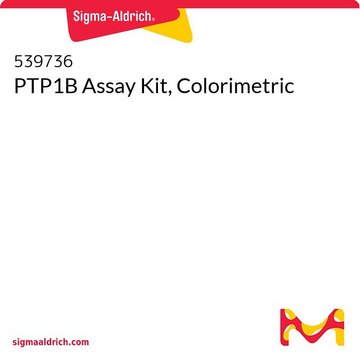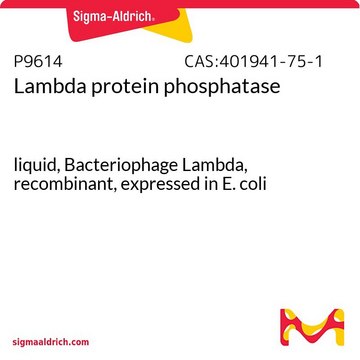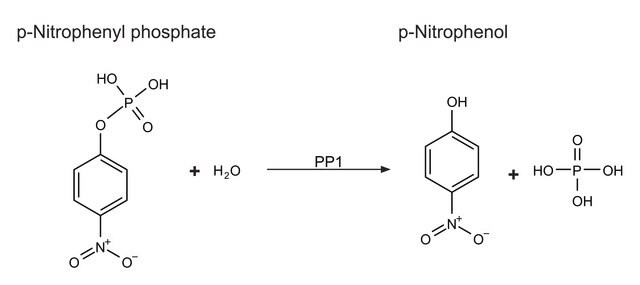539735
PTP1B, Human, Recombinant, E. coli
Synonym(s):
Protein Tyrosine Phosphatase 1B
Sign Into View Organizational & Contract Pricing
All Photos(1)
About This Item
UNSPSC Code:
12352202
NACRES:
NA.77
Recommended Products
biological source
human
Quality Level
recombinant
expressed in E. coli
assay
≥90% (SDS-PAGE)
form
liquid
specific activity
≥20 U/mg
mol wt
37,400 g/mol
manufacturer/tradename
Calbiochem®
storage condition
OK to freeze
avoid repeated freeze/thaw cycles
shipped in
wet ice
storage temp.
−70°C
Gene Information
human ... PTP1B(5770)
General description
Research area: Cell Signaling
Recombinant, human PTP1B expressed in E. coli. PTP1B, an ubiquitous nontransmembrane protein tyrosine phosphatase, was originally identified in human placenta. This highly active enzyme is useful for the study of tyrosine phosphatase kinetics, substrate specificity, and for screening inhibitors. PTP1B comprises three domains: an N-terminal catalytic domain (1–300), a regulatory domain (301–400), and a C-terminal domain (401–435) that is accountable for directing the enzyme to the endoplasmic reticulum (ER) membrane.
Recombinant, human PTP1B expressed in E. coli. PTP1B, an ubiquitous nontransmembrane protein tyrosine phosphatase, was originally identified in human placenta. This highly active enzyme is useful for the study of tyrosine phosphatase kinetics, substrate specificity, and for screening inhibitors. PTP1B comprises three domains: an N-terminal catalytic domain (1–300), a regulatory domain (301–400), and a C-terminal domain (401–435) that is accountable for directing the enzyme to the endoplasmic reticulum (ER) membrane.
Application
Protein tyrosine phosphatase 1B (PTP1B), Human, Recombinant, E. coli has been used in the dephosphorylation assay of Glutathione S-transferase (GST) fusion proteins as well as in the in vitro kinase assays. It has also been used to construct a 66-member PTP1B library for discovery of enzyme inhibitors using click chemistry.
Biochem/physiol Actions
Protein tyrosine phosphatase 1B (PTP1B) serves as a crucial enzyme in dephosphorylating insulin receptor and its downstream signaling components. Furthermore, it participates in the negative regulation of the leptin signaling pathway by dephosphorylation of the upstream signaling molecules, leading to the suppression of the neuropeptide Y synthesis, an appetite-stimulating hormone. Improper functioning of PTP1B has been associated with a variety of human diseases, including cancer, diabetes, obesity and inflammation.
Packaging
Please refer to vial label for lot-specific concentration.
Warning
Toxicity: Standard Handling (A)
Unit Definition
One unit is defined as the amount of enzyme that will hydrolyze 1 µmol of phosphopeptide substrate (Cat. No. 539737) per min at 30°C, pH 7.2 using 150 µM of substrate.
Physical form
In 50 mM HEPES, 1 mM DTT, 1 mM EDTA, 0.05% NP-40, pH 7.2.
Reconstitution
Following initial thaw, aliquot and freeze (-70°C).
Other Notes
Puius, Y.A., et al. 1997. Proc. Natl. Acad. Sci. USA94, 13420.
Liu, F., et al. 1996. J. Biol. Chem.271, 31290.
Liu, F., et al. 1996. J. Biol. Chem.271, 31290.
Legal Information
CALBIOCHEM is a registered trademark of Merck KGaA, Darmstadt, Germany
Storage Class
12 - Non Combustible Liquids
wgk_germany
WGK 1
flash_point_f
Not applicable
flash_point_c
Not applicable
Certificates of Analysis (COA)
Search for Certificates of Analysis (COA) by entering the products Lot/Batch Number. Lot and Batch Numbers can be found on a product’s label following the words ‘Lot’ or ‘Batch’.
Already Own This Product?
Find documentation for the products that you have recently purchased in the Document Library.
Our team of scientists has experience in all areas of research including Life Science, Material Science, Chemical Synthesis, Chromatography, Analytical and many others.
Contact Technical Service







